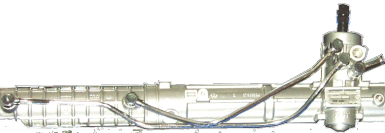|
|
Hydraulic Power Steering
Power steering should enable a relatively direct steering, with little effort. The feeling for the road surface, should however, still be maintained. The impact from
uneven roads should not be
transferred to the steering.
The best way to understand it, is to enlarge figure 2 to the max. From below, the steering column goes through the rack and pinion, to the two ball joints on the left and on the right. On the way to the right joint, a dividing
piston is visible in the cut-open view. It separates the two working areas from each other. The right side contains hydraulic oil if the gear rack moves to the left, and thus, the steering to the right. At the same time the
hydraulic oil in the left working area must be able to flow without pressure back into to the reservoir.
When steering to the left, the controller swaps the pressure pipe and the fuel return around. This can be seen immediately behind the universal joint in the steering column. You can even partially follow the two pipes
to the working areas. The two connections to the hydraulic pump and to the container are open. Here, in the controller, it is decided whether, and which side receives support. This is triggered through the steering
movement by the driver.
Now look at the diagram (figure 1). A high-pressure oil pump driven by the engine must be available. Here a double-action vane-type pump (on the
right) is particularly suitable
because of its constant high and continuous feed rate. Before entering into the steering gear a controller (details on top and on the left) is installed in the steering shaft. This becomes effective with the slightest turning
of the steering wheel. depending on the rotation direction of the steering wheel, the side which supports a particular steering movement is activated.

In the recirculating-ball-hydro-steering there are two areas, sealed off from each other on both sides of the steering nut. Both can be alternatively,
under pressure, or be
connected with the reservoir in the flow-back. Thereby, lighter steering also becomes possible. At full steering angle, the pressure relief valve comes into action, thus protecting the oil pump against overloading. To
increase the road-feeling, the supporting oil-pressure can be reduced with rising speed.
Even though the servo-valve and the oil circulation amount have been clearly reduced in the course of the development, a relatively high amount of effort is necessary for the installation of hydraulic power steering. After
all, a pump with a constant drive exists in the engine, which complicates a modular construction method. In addition, every small steering movement causes the consumption of support energy. Alternatively, some
manufacturers install an electric power steering. 08/07

|
|